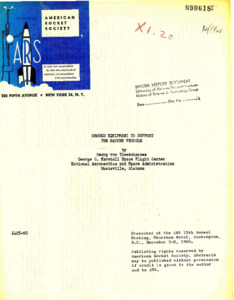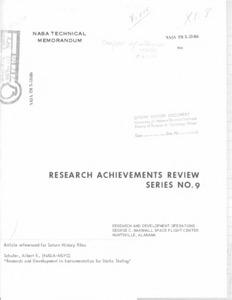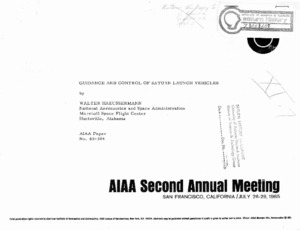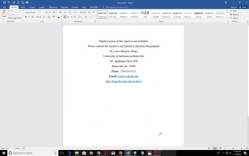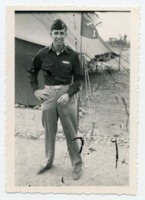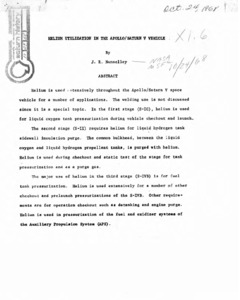
Browse Items (8218 total)
Sort by:
-
"Ground Breaking Ceremony, University of Alabama Research Institute, Huntsville, Alabama, December 20, 1962."
The program includes a short history of the Research Institute and a program of events, featuring remarks from Rudolf Hermann, Wernher von Braun, and Alabama Governor John Patterson. The back page shows a map of Huntsville with directions from the Huntsville Armory to the Research Institute. -
"Ground Equipment to Support the Saturn Vehicle."
With the advent of the first large space vehicle, the SATURN, the ground support equipment and launch facility designer is faced with the necessity of conceiving and building an unprecedented launch system concurrent with the vehicle development. The paper intends to present a comprehensive picture of the problems involved and how they are solved. It follows the SATURN through the various modes of operation such as transportation over land and water, checkout, handling and erection, propellant loading, and describes the facilities at the launch site. -
"Ground testing at MSFC : research achievements review series no 9"
In 1955, the team which has become the Marshall Space Flight Center (MSFC) began to organize a research program within its various laboratories and offices. The purpose of the program was two-fold: first, to support existing development projects by research studies and second, to prepare future development projects by advancing the state of the art of rockets and space flight. Funding for this program came from the Army, Air Force, and Advanced Research Projects Agency. The effort during the first year was modest and involved relatively few tasks. The communication of results was, therefore, comparatively easy.; Pages of handwritten notes on yellow legal paper. There is also a 3 x 5 inch card with this information. Article reference for Saturn History Files: Schuler, Albert E. (NASA-MSFC) Research and development in instrumentation for static testing. -
"Groundbreaking Ceremony: Constitution Hall Park."
Speakers included James Record, Frances Roberts, and Huntsville Mayor Joe Davis, with an invocation by Rev. Donald L. Bailey and a benediction by Rev. Lee Hudson. The program includes a map of Constitution Hall Park. -
"Guidance and Control of Saturn Launch Vehicles."
The navigation, guidance, and control modes and problems of the Saturn launch vehicles are given as the requirements for the guidance and control methods. Two path adaptive guidance modes, featuring flight path optimization, in the form of a polynomial mode and an iterative mode are given in their computation form and compared with respect to mission flexibility, implementation requirements, and performance. Attitude control during the propelled flight phases requires consideration of various bending and sloshing modes; stability of the control system is obtained by phase stabilization of the low frequencies and by attenuation of the higher frequencies. Typical shaping networks and their transfer functions are given. The attitude control system during coasting periods is briefly described. The functional behavior and characteristic data of the main guidance and control hardware such as the inertial sensors, stabilized platform, digital computer, data adapter, control computer, and actuation system are described. Reliability requirements are emphasized. The principle of redundancy is extensively used to obtain highest reliability for long operating times. Data and results from recent Saturn I flights summarize the performance of the guidance schemes. -
"H-1 rocket engine: models H-1C and H-1D : technical manual engine data."
Poor jpeg of a screenshot of a word-document. -
"Handshake in Space" (Apollo-Soyuz: U.S. and Soviet rendezvous in space)
A photo of Thomas P. Stafford and Alexei Leonov shaking hands in space after a successful docking between the Apollo and Soyuz spacecrafts. -
"Haskins Makes Quick Change from Civilian Ph.D. to Pfc."
Clipping from the Redstone Rocket, March 2, 1954. The article highlights Haskins' background as a physicist and his role in the 9330 Technical Service Unit. -
"Helium Utilization in the Apollo/Saturn V Vehicle."
Helium is used extensively throughout the Apollo/Saturn V space vehicle for a number of applications. The welding use is not discussed since it is a special topic. In the first stage (S-IC), helium is used for liquid oxygen tank pressurization during vehicle checkout and launch.

